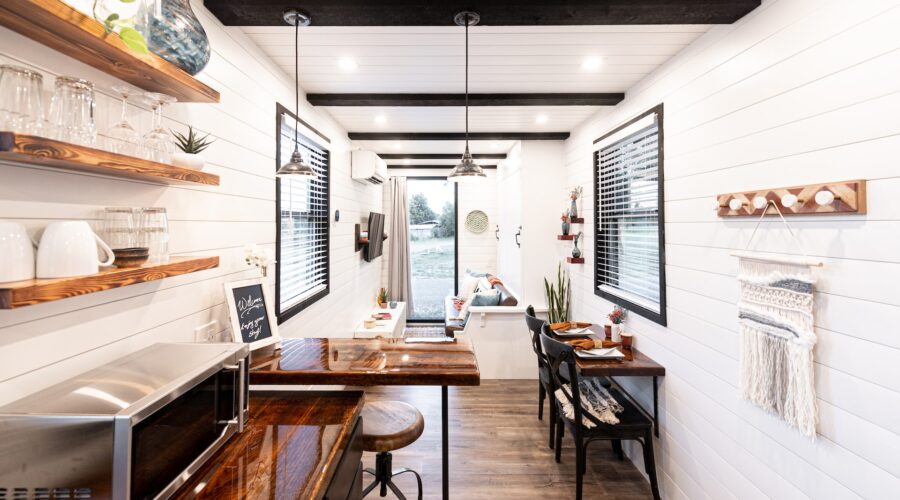Tiny homes have seen an impressive increase in popularity over the last few years, largely due to a growing interest in minimalism and sustainability. Tiny homes are easy to maintain, cost-effective, and allow people to live in more rural areas without having to worry about building or buying a cabin or farmhouse.
But, there are some drawbacks to the tiny home movement. In many areas of the U.S., for example, tiny homes are illegal to own or reside in full-time. In other areas, they’re subject to strict zoning laws.
If policies were different when it came to building and owning tiny homes, it could potentially solve several major social issues our country is facing, including our homelessness crisis.
Let’s take a closer look at some of the politics around tiny home living, and if this movement is truly the best solution to homelessness and carbon footprint problems.
Housing shortages and community planning
Most people don’t associate tiny home living with major cities where you can walk anywhere you need in a matter of minutes. Rather, they’re often associated with more rural living. Tiny homes are often built in wooded areas or small communities that are far enough away from city life to allow people to enjoy the serenity of nature.
However, it’s important to note that many rural areas in the country are facing a housing crisis. The need for housing in rural America is largely due to levels of poverty in those areas. People often struggle with health barriers in these areas. There can be a lack of nutritious food available, as well as substandard medical care or few resources for getting emergency medical help.
Tiny homes could be particularly relevant when it comes to housing shortages in these areas. Not only could they provide safe spaces for those struggling to find affordable homes, but tiny home communities could be built in those areas.
Sustainability efforts
The concept of tiny homes boosting sustainability makes sense. After all, a smaller home is going to use fewer resources. But just how sustainable are they?
The bigger a home, the more energy it takes to maintain it. Tiny homes use less energy and create less waste. You simply don’t have room for too much “stuff”, so you’re forced to rely on less, which can ease the strain on our natural resources. Some people who have the opportunity to construct new tiny homes for themselves take sustainability efforts a step further by installing things like:
- Solar panels
- Blackout shades
- Low-flow faucets and toilets
- LED lighting
On average, a tiny house uses less energy than a traditional home. Not only will you see savings in your utility bills each month, but if more tiny homes were created – especially in urban communities that are prone to blackouts – we could conserve more energy and focus on the switch to renewable resources in the future.
The solution for a struggling homeless population?
Tiny homes have been a bit “glamorized” over the years thanks to the minimalist movement. You’ve probably seen them on Pinterest and TikTok, taken over by people who certainly have the income to build and create the home of their dreams. There’s absolutely nothing wrong with choosing to “downsize” and live in a tiny home if you’re independently wealthy.
But, it’s time to look at the bigger picture when it comes to what these homes could be used for – especially from a societal and political standpoint.
Housing shortages aren’t only affecting our rural populations. There’s also a major homelessness issue impacting the country, especially in urban areas. Tiny homes – especially tiny home villages – could be the answer for some members of the homeless population. First, they’re cost-effective, and easier to construct than the average home. Tiny homes are a type of modular construction. They’re easy to put up quickly and can make things easier for people to “DIY” the process, or for local government organizations to create tiny home villages within a reasonable budget and timeframe.
Of course, there’s always the issue of safety and durability. Any tiny home construction, especially done in larger quantities, needs to be safe, dignified, livable, and up to code. The fact that low-income individuals aren’t always able to find safe housing is largely a political issue, and creating communities of small homes, even in central city locations, could reduce those risks and create safer city populations.
Tiny homes aren’t necessarily a “cure-all” for the issues our country is facing. However, it’s clear that when these homes and communities are created with intention and planning, they can make it easier to manage some of the social and economic issues of the day.
So, it should come as no surprise that the movement continues to grow, and will likely see an even sharper incline as more governments and private organizations get involved.
Photo by Jed Owen

